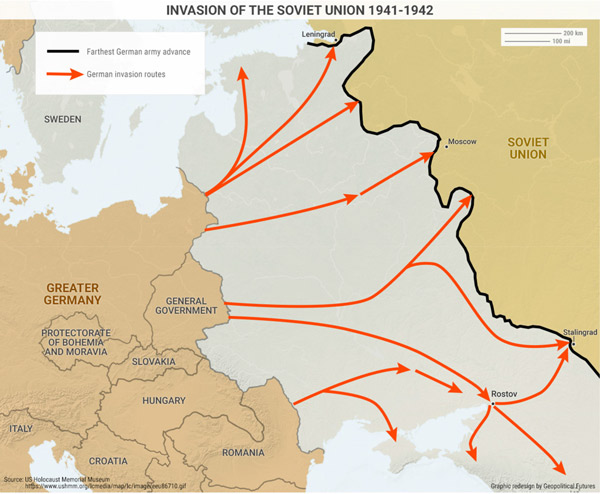This Map Shows Germany’s Critical Mistakes Fighting Russia in WWII
- Meredith Friedman
- |
- November 29, 2017
- |
- Comments
BY GEOPOLITICAL FUTURES
The Battle of Stalingrad had its origins in a pivotal German miscalculation at the start of World War II.
Operation Barbarossa, the code name for Germany’s invasion of the east, was designed to destroy the Soviet Union, securing Germany’s eastern flank, and so guaranteeing German control of Continental Europe (George Friedman wrote about Germany’s geopolitical grand strategy in his exclusive e-book, The World Explained in Maps, which you can download here.)
The invasion began on June 22, 1941. But the Germans made a critical error even before the invasion began.
A Critical Error
Barbarossa was a three-pronged attack.
One prong was into the Baltic states and then toward Leningrad (modern day St. Petersburg), the second was toward Moscow, and the third was into the south in order to capture Ukraine and then the Caucasus.
Formulating the plan in this way violated one of the principles of warfare, one sacred to the German high command: the concentration of forces. By dividing their forces, none of the Germans’ goals were achieved.
Leningrad held out in spite of Germany’s blockade, the Germans were stopped just outside of Moscow, and the southern thrust wasn’t set up to succeed.
The Germans’ Blunder Was Rooted in an Intelligence Failure
The Abwehr (Germany’s military intelligence) severely underestimated the size of Soviet reserves. Based on those estimates, German high command mistakenly believed it didn’t need to concentrate its forces.
The Germans envisioned an initial battle of encirclement to capture Soviet armies, followed by an advance against feeble reserves, ending in victory well before the end of winter 1941.
This intelligence failure cost the Germans a victory that year. They might have knocked the Soviet Union out if they had taken Moscow, but that’s unclear.
Leningrad was a strategic sideshow. But the war could certainly have been won in the south. And the crucial battle in the south was at Stalingrad.
Underestimating the Enemy
Modern wars and economies run on oil, and the Soviets’ major source of oil was Baku in Azerbaijan. The city had been Europe’s first major source of oil.
Had the Germans focused their entire invasion on the south and captured the land bridge between the Volga and the Don rivers, Baku’s oil wouldn’t have been able to flow to Soviet factories, and no amount of lend-lease could have made up for it.
But because of their faulty intelligence, the Germans thought they could attain all three goals in 1941.
They were wrong.
Grab George Friedman's Exclusive eBook, The World Explained in Maps
The World Explained in Maps reveals the panorama of geopolitical landscapes influencing today's governments and global financial systems. Don't miss this chance to prepare for the year ahead with the straight facts about every major country’s and region's current geopolitical climate. You won't find political rhetoric or media hype here.
The World Explained in Maps is an essential guide for every investor as 2017 takes shape. Get your copy now—free!

